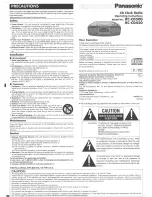
FEATURES AND OPERATION
2-8
Part No. 001-4090-101/102
The COM port will support 7 or 8 data bits, one or two stop bits, and even, odd or no parity.
Selection is made via the Radio Service Software (RSS). These parameters may be set differently on
various Integra-H units without affecting their ability to communicate with each other.
2.4.5 ADDRESSING
Each Integra-H is associated with three identification numbers (addresses):
ESN:
The Electronic Serial Number is uniquely assigned to each Integra-H at time of
manufacture and cannot be changed. It is identical to the serial number printed on the label of the unit.
Integra-H uses this number for identification only; it does not form part of the on-air protocol. The ESN
of a remote unit may be viewed with the RDS by doing a
Remote GET
.
Short ID:
The short ID (maximum value of 254) is used to identify Integra-H for purposes of
diagnostics (both online and offline), remote configuration and commands. The default value of the short
ID (set at factory) is calculated from the ESN. This value may be changed via the Integra RSS. It is
important that all stations within a communicating group have unique short IDs.
Station Type:
This is a 1-bit value used to identify the station as a master or remote. See 2.4.6.
2.4.6 STATION TYPE
On simplex or repeater networks, all remote stations can hear the master and many remote
stations can hear each other. Certain SCADA user protocols are designed with the assumption that
remote stations cannot hear the responses to polls made by other remote stations.
To allow operation with such protocols in simplex networks, Integra-H has a simple addressing
scheme. Stations may be designated as master or remote. This sets a flag in the header identifying the
type of the originating station.
On the receive side, Integra-H stations can be set to accept all data, or accept data only if it
originates from a station
of the opposite type
(selective). This choice is made by setting Data Delivery
to selective or all using the RSS.
2.5 ONLINE DIAGNOSTICS
Online diagnostics may be enabled or disabled on a per-unit basis without affecting inter-
communication. Enabling this option adds about 2.5 ms delay at 19.200 b/s, 5 ms at 9600 b/s or 10 ms at
4800 b/s to each transmission, but has no other effect on network operation. At the beginning of each
data transmission from a unit, diagnostics are delivered locally to its own setup port regardless of the
Online Diagnostics setting. If user-enabled, diagnostics are also sent on the network.
















































